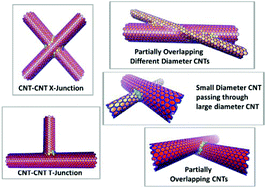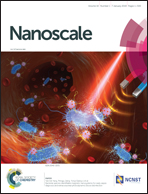Developing nanotube junctions with arbitrary specifications†
Abstract
Experimentally synthesized carbon nanotube (CNTs) junctions (either single or with 2D/3D CNT network topology) are expected to have random orientation of defect sites (non-hexagonal rings) around the junction. This random and irregular nature of the junction topology and defect characteristics is expected to affect their strength and durability as well as impact the associated mesoscopic and macroscopic properties. On the contrary, theoretical and computational studies often investigate structure–property relationships of pristine and regular junctions of carbon nanostructures. In this study, we developed a computational framework to model a variety of junction structures between CNTs with arbitrary spatial (orientation and degree of overlap) and intrinsic (chirality) specifications. The developed computational model also has the ability to tune the degree of topological defects around the junction via a variety of defect annihilation approaches. Our method makes use of the primal/dual meshing concept, where the development and manipulation of the junction nodes occur using triangular meshes (primal mesh), which is eventually converted to its dual mesh (honeycomb mesh) to render a fully covalently bonded CNT junction. Here each carbon atom has 3 bonded neighbors (mimicking sp2 hybridization). Under a given set of CNT orientation, overlap and chirality specifications, the approach creates a number of CNT junction configurations with varying degrees of energetic stability, offering an opportunity to investigate the effect of topological arrangement of defects around the junction on mechanical, electrical and thermal properties. In addition, it is shown via few examples that the discussed methodology can easily be extended to create multi-junction nanotube clusters, multi-wall nanotube junctions, as well as true 3D random network structures.



 Please wait while we load your content...
Please wait while we load your content...